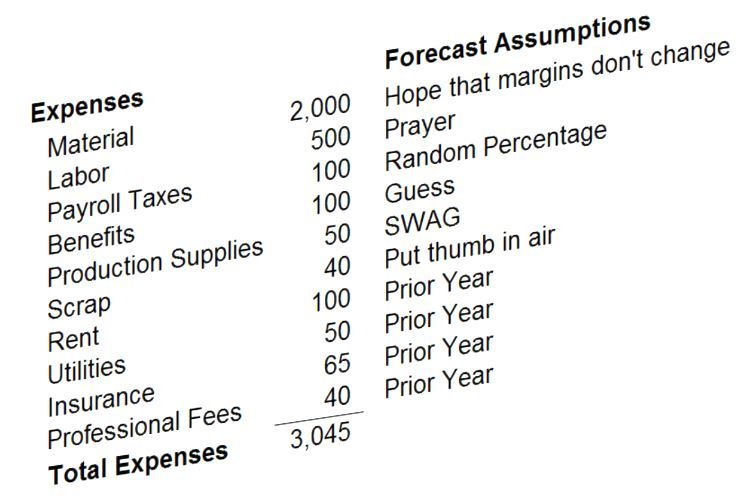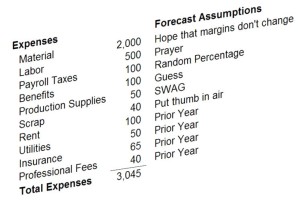We have discussed the challenges in producing a realistic sales forecast in the past. Not to discount the importance of the top line, but it is only one driver of an organization’s performance (though a VERY important driver). I’ve witnessed many organizations that have sufficient revenue, but still lack profitability, hence the problem lies in the expenses.
History can be a great place to look at expenses to get a good gut feel for the trends and run rate. In most instances, just using historical levels for every category will be reasonable and get you in the ballpark. There are many times where a “back of the envelope” or white-boarding exercise will suffice. However, if you are getting paid to make sure it all makes sense, and plan to measure results against this, then you actually need to go a few steps further.
Always keep in mind, the sales forecast needs to be considered in conjunction with the expenses. Here are some key areas to focus on:
- Customer and product mix – If margins vary for different customers and / or products, then this needs to be considered when forecasting the variable product costs. Ideally, a company can forecast based upon units, that way the variable costs (raw materials, labor, other processing inputs) can be forecasted more accurately (instead of just relying on percentages). Another advantage to using unit volumes is that pricing concessions or price increases can be incorporated much easier. Next, if there are any products that need to be phased out, write-offs or markdowns may need to be taken into consideration. Finally, look at the trends in product costs. While commodity prices have been trending down recently, that is not always the case.
- Labor – Although this was briefly mentioned above, this is one area that is usually the most critical to manage. While product costing can average out the labor cost to a fraction of time, laborers are always present in much larger blocks of time. If your business is based on same day turnaround of orders, you may not know your full labor needs for the day until after your employees are already there. It is helpful to have a very good understanding of how efficient the labor utilization is over time.
- Resource capacity – If a forecast is calling for an increase in sales, are the right resources on hand, or available? While equipment capacity might be the obvious thing to consider, there are other resources that need to be contemplated. If a business has an open shift, that might mean additional capacity is available. However, the labor pool for non-primary shifts may not be as deep or as adequate. Adding a new product line can result in inefficient operations until all the kinks are worked out, this usually takes longer than anyone initially plans.
- Seasonality – Businesses with seasonal fluctuations need to consider the ramp-up costs associated with either labor and / or production. If you are forecasting resources based on a certain level of productivity, keep in mind that temporary or new workers will not be as efficient and are likely to create more mistakes (higher scrap, customer credits, etc.). Of course, this also highlights the need for having good onboarding / training as well as more “foolproof” processes.
Other considerations that should be taken into account include:
- Fixed Costs – Certain fixed costs, such as rent, insurance and professional fees, can usually be determined based on contracts, or history, with a large degree of accuracy.
- Form of payment – If customers transition to paying with credit cards, that can translate to 2-3% of sales in credit card fees. However, it should free up resources in chasing customer payments.
- Timing – While forecasting on an annual basis is one thing, forecasting at a monthly level is crucial in order to project cash flows and capital requirements. Expenses that can be seasonal, or front loaded in the calendar year (worker’s comp insurance, for instance) need to be adjusted accordingly.
At the end of the day, the forecast will tell the story of what should happen. Having a good management team, adequate reporting, and the right controls in place will go a long way in determining what WILL happen.


